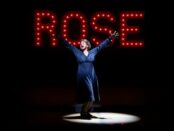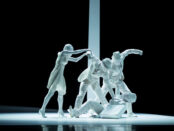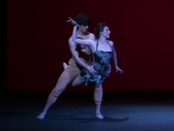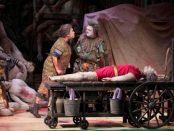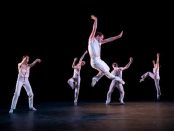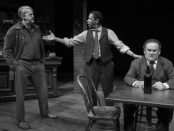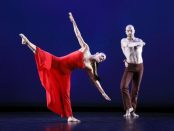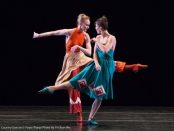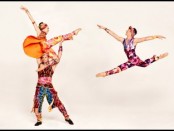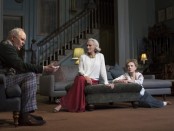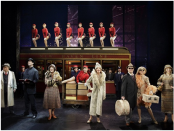Santo Loquasto
Brooklyn Laundry
John Patrick Shanley has become our poet of lonely, desperate working class people trying to make a connection despite their inadequacies and hang-ups in such plays as "Danny and the Deep Blue Sea," "Savage in Limbo," "the dreamer examines his pillow," "The Big Funk" and "Outside Mullinger" and, of course, in his Academy Award-winning script for "Moonstruck." In all of these works, the pair makes an unlikely couple who fight against their very attachment as outside of the realm of possibility. In his latest play, the bittersweet "Brooklyn Laundry," he creates another lovely story of an unlikely couple Fran and Owen who find each other just when they need someone most. [more]
Twyla Tharp Dance: Winter Season 2024
Like her masterful Sinatra solo for Mikhail Baryshnikov, “Brel” takes Cornejo from a strolling meditating figure (“Quand On N’A Que l’Amour”) to an anguished lover (“Ne Me Quitte Pas”). Cornejo twists and thrashes until the song “Amsterdam” had him gliding all over the stage. The mood rises through “Les Marquises” and “Marieke,” matching Brel’s penchant for crescendo, leading Cornejo into jags of runs, leaps, turns and wilder gestures. Although not as immediate a success as her other ballets to songs, “Brel” will soon be a favorite of solo danseurs all over the ballet world. [more]
Alvin Ailey American Dance Theater: Spring 2023 Season
"Dancing Spirit" was a gentle ballet choreographed by Ronald K. Brown to a suite of music by Duke Ellington, Wynton Marsalis, Radiohead and War. First one dancer, then two and then the entire cast slowly made their way down a darkly lit diagonal (perfect lighting by Clifton Taylor) dressed in Omotayo Wunmi Olaiya’s white flowing dresses for the women and dark pants and pale shirts for the men. This was a ritualistic journey. The simple movements—walking, tilting, dipping into deep, wide pliés and bending at the waist—were developed into complex combinations all to quiet music of Ellington. [more]
Twlya Tharp: “In the Upper Room” & “Nine Sinatra Songs”
A scene from Twyla Tharp’s “In the Upper Room” at New York City Center (Photo credit: [more]
Pacific Northwest Ballet 2022
For the company’s director, Peter Boal, this short season was a homecoming of sorts. He was a principal dancer in the New York City Ballet which calls the David H. Koch its artistic home. He left seventeen years ago and, since 2005, has been the PNB’s artistic director. Boal should have put more thought into the ballets he brought, at least those on Program A. Only one of three had heart and emotional depth and was gimmick-free. All three works by established choreographers showed off different facets of the skilled dancers. [more]
Paul Taylor Dance Company 2022
The new work on the program, a world premiere, was “Hope Is the Thing with Feathers” by Michelle Manzanales, choreographed to John Lennon & Paul McCartney, Bob Marley, Harry Woods and several others. Using ten of the Taylor dancers, Manzanales produced a work that was charming if a tad repetitious. Santo Loquasto’s pale costumes had an elegantly informal look. The dancers trooped on in a long line performing unison steps, lunges, leans and twists until movements moved sequentially down the line, mostly soft falls to the stage. In between these unison sections there were jaunty solos and quick duets that segued into group dances. The pop song soundtrack underlined the work’s informal feel. Manzanales certainly put the dancers through their paces. There’s nothing more appealing to an audience than a line of performers dancing their hearts out in unison! Her work shows promise but also is clearly the work of a novice. What the ballet had to do with the Emily Dickinson poem it came from wasn’t clear. [more]
The Music Man
Because of changing social mores, some Broadway musicals are assumed to make audiences uncomfortable today. Take for example Rodgers and Hammerstein’s "Carousel" whose protagonist is a wife-beater. The recent revival did everything in its power to mitigate this problem but did not succeed. Now we have the long awaited revival of Meredith Willson’s "The Music Man" starring film megastar Hugh Jackman as Professor Harold Hill and two-time Tony Award-winner Sutton Foster as Marian Paroo, the librarian and music teacher. The problem the director and producers had with this classic piece of Americana, set in 1912, is that the hero Professor Hill is a con-artist and a serial seducer with whom we are supposed to be sympathetic. However, in 2022 this is an obstacle in an era when lovable rogues are not acceptable as heroes. As a solution, Jackman has been directed by Jerry Zaks to play Harold Hill as low-key and muted as he possibly can. What this does is straitjackets Jackman’s personal charm and charisma which he normally has in spades. The result is an undercooked Music Man even though it has been given a big, expensive production – six Tony Award winners on stage and six in the production team - maybe the starriest cast in New York right now. [more]
Twyla Now
After a pause, there was the world premiere of "Second Duet." It was the most dramatic and emotional dance of the program. Wearing sneakers and casual sportswear, Cassandra Trenary and Aran Bell of American Ballet Theatre were the handsome couple whose tempestuous and turbulent relationship ranged from argumentative to violent to clinging and physically dependent. Tharp’s choreography included complicated partnering in which elements of the relationship were uncomfortable and disturbing, or sometimes amusing (as an example, Trenary stood solidly and dared Bell to just try and pick her up). Without an actual story line, the dance was emotionally charged, revealing and riveting. Trenary and Bell gorgeously performed the complex choreography. Looking more like members of a modern dance troupe than classical ballet dancers, they brought emotional depth as well as physical ability to this taxing piece of work. A modern music mix by Thomas Larcher and Aztec Camera played by the musicians Stephen Gosling (piano) and Gabriel Gabezas (cello) was sometimes as appropriately discordant as the relationship. [more]
Gary: A Sequel to Titus Andronicus
Playwright Taylor Mac’s Broadway debut, "Gary: A Sequel to Titus Andronicus," comes with a great many pluses: three consummate clowns, Nathan Lane, Kristine Nielsen and Julie White, directed by George C. Wolfe, and a terrific set by Santo Loquasto. This ribald yet philosophical downtown comedy is making its debut at the Booth Theatre, usually home to sedate, serious dramas. While low humor seems to be the name of the game, the play also has a good deal to say on various topics like comedy and tragedy, political systems, class structure, the little people who generally do the dirty work, and parodying Elizabethan revenge plays. The humor in Gary is not for everyone, but those who relish low comedy will have a ball as do the actors on stage. [more]
Twyla Tharp: Minamalism and Me
Her quietly wry, gently self-deprecating autobiographical lecture demonstration, “Minimalism and Me,” was the first half of a program devoted to her early works. These works more often than not caused more chin scratching than accolades. From the virtually motionless “Tank Dive” to the giddy, if slight, “Eight Jelly Rolls,” her intellectual processes—including stacks of graph paper jottings that guided her and her dancers on stage (or on gymnasium floors, museum exhibition rooms and outdoor spaces)—were sensible yet challenging to the status quo of the 1960’s when she did her first choreographic experiments with her all-female quintet. [more]
The Iceman Cometh
Denzel Washington, the raison d’être of this production (coming way too soon after several recent stagings), gives a boisterous, almost pleasant performance as Theodore Hickman, aka Hickey, who is the “Godot” of "Iceman," in whom the godforsaken characters put too much faith, a faith that, by the end of the play, is shown to be clearly misplaced. There is absolutely no foreboding in his interpretation. He takes the glad-handing aspect of Hickey too literally so it is difficult to understand his sway over the denizens of Harry Hope’s saloon. True, these depressives look forward to his regular visits, but Washington’s Hickey simply doesn’t fit in. He’s more worshiped than embraced. [more]
Carousel
If it seemed like no staging could ever top London’s National Theatre production (which was directed by Nicholas Hytner and came to Lincoln Center in the mid 1990’s), this newer version epitomizes the notorious relationship between anticipation and realization. Though the advance word during the extensive preview period was rather negative, Jack O’Brien’s "Carousel" proves up there with the best. [more]
Paul Taylor American Modern Dance: Spring Season 2017
Now named Paul Taylor American Modern Dance, Taylor has included ballets by other choreographers which allows for some healthy comparisons and a hope for the future of this legendary company. The four non-Taylor works, all but one danced by the Taylor dancers, made fascinating comparison with his work: particularly Martha Graham’s “Diversion of Angels,” her ode to romantic and sexual love, choreographed in 1948 to music by Norman Dello Joio, one of the few works in which Graham, herself, did not appear. [more]
Twyla Tharp and Three Dances
From 1976, “Country Dances” represented the post-experimental avant-garde phase after breakout success with her ballets for major dance companies. From 1980, there was “Brahms Paganini,” her entrée into her hybrid style combining her eccentric, seemingly casual movements with the classical ballet vocabulary and from 2016, “Beethoven Opus 130,” virtually a classical ballet with quirky touches. [more]
Shuffle Along, or the Making of the Musical Sensation of 1921 and All that Followed
"Shuffle Along..." follows the travails and triumphs of the creators of the 1921 David that fought what was at first a losing battle against the Goliath of the Broadway powers-that-be. The quartet that put the show together on a long road tour were libretto creators F.E. Miller (Brian Stokes Mitchell whose charisma and mind-boggling professionalism makes his character the safe harbor) and his partner, Aubrey Lyles (Arbender Robinson, brilliantly taking on the part usually played by Billy Porter); composer, Noble Sissle (Joshua Henry, giving a quietly dignified performance as an artist whose disappointment in America takes him to Africa) and lyricist, Eubie Blake (Brandon Victor Dixon, the more effervescent and demanding of the two songwriters). [more]
Prodigal Son
Television and film actor Timothée Chalamet (Showtime’s "Homeland" and Christopher Nolan’s "Interstellar") makes an impressive New York stage debut as the play’s young protagonist. The role is almost too small to contain his bigger-than-life portrayal: kinetic, animated, provoking, questioning, vital, dynamic. His moods turn on a dime and he can shift from being a sophisticated adult back to being a little boy in a moment. Tall and lanky, he suggests the author but as he must have looked back in 1965. Also making his Manhattan Theatre Club debut, David Potters as his roommate Austin is tremendously sympathetic as a young man afraid of breaking the rules who has led a very sheltered life up until now. [more]
Our Mother’s Brief Affair
Linda Lavin wears Anna in Richard Greenberg’s "Our Mother’s Brief Affair" like a chic couture outfit with many layers each of which reveals layers of colorful, woven cloth. There is a constant glow about her as she relates, mostly in flashbacks, the story of an illicit, but exciting affair with a stranger she met many years ago while waiting for her son, Seth (a bemused, but effective Greg Keller) to emerge from his Juilliard viola lessons. [more]
Twyla Tharp 50th Anniversary Tour
Twyla Tharp is a choreographer who can infuriate and charm audiences in equal measure. (Paul Taylor also comes to mind.) Her choreography is clearly the result of an intensely fertile mind, but her very personal, quirky movement style often seems arbitrary and unmusical. Her program at the David H. Koch Theater, marking the end of her 50th Anniversary Tour, was filled with her quirky idiosyncratic, non-stop movements, beautifully danced, but finally becoming an onslaught of just too many ideas—some corny, some brilliant—flung at the music and the audience. [more]
Of Good Stock
Plays about three very different sisters go back to Shakespeare’s "King Lear." In modern times, the topic immediately recalls Chekhov’s "Three Sisters" and more recently Wendy Wasserstein’s "The Sisters Rosensweig" and Beth Henley’s Pulitzer Prize-winning, "Crimes of the Heart." Melissa Ross, whose excellent Nice Girl just completed its world premiere at the Labyrinth Theater Company, has entered the fray with "Of Good Stock" with a cast led by film star Alicia Silverstone returning to the New York stage. While the play is entertaining and believable under Lynne Meadow’s direction, it is also overly familiar without revealing any new depths. [more]
Paul Taylor’s American Modern Dance 2015
What became clear over the course of the four performances under review attended were the subtle changes in Mr. Taylor’s work over the years, how his works have become less deep and more oddball. This was a terrific way to see everything from his delightfully lovely “white” ballet, “Aureole” (1962), to his most recent opus, “Death and the Damsel,” a dark, distorted—sadistic, even—view of female sexuality. No matter what period the works come from, and no matter what one thinks of them, they are always models of craftsmanship, design and musicality. [more]
Edward Albee’s A Delicate Balance
Although the play is written in the retro form of upper middle class drawing room comedy, it has a serious message and theme. The fear or terror that Edna (Higgins) and Harry (Balaban) bring to the home of Agnes (Close) and Tobias (Lithgow) is that which all people have to deal with: loneliness, abandonment, illness, ageing, death. When asked what one of his plays was about, Harold Pinter, a playwright with a similar sensibility to Albee, declared, “The weasel under the cocktail cabinet.” On a surface level, this flippant remark appears meaningless, but on deeper level it means the hidden fears that lurk in the dark corners of our lives to which we avoid giving a name. This also sums up the theme of Albee’s play which is couched in difficult set pieces and elliptical dialogue. [more]
Bullets Over Broadway thoughts from Chip Deffaa’s July 17, 2014 column
Some of these great old songs will be unknown to the average theater-goer of today; they are so old they might as well be new. And they are a joy to hear. What a treat it is, for example, to hear Jelly Roll Morton's "Good Old New York." This is a superior melody by a major jazz composer. It will be new to most audience-members. It's done with respect and flair. And it's a just a pleasure to hear. That number is over all too soon. [more]

